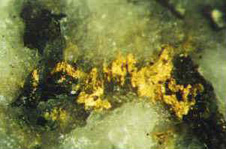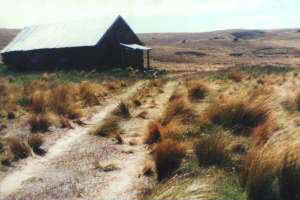 1. An irregular piece of gold, 3 mm long, in quartz from the Callery valley, Southern Alps. This gold formed less than one million years ago, by hot water processes near the Alpine Fault. Similar processes formed gold in the mountains that made up Otago 150 million years ago.
1. An irregular piece of gold, 3 mm long, in quartz from the Callery valley, Southern Alps. This gold formed less than one million years ago, by hot water processes near the Alpine Fault. Similar processes formed gold in the mountains that made up Otago 150 million years ago.  2. Serpentine Diggings, Central Otago. A gold-mining ghost town, with the only remaining building being the old church. This scene is typical of Otago's tussock-grass covered uplands. Gold-bearing quartz veins are exposed at the surface on the hills in the distance, and alluvial gold workings are scattered in the streams in the foreground.
2. Serpentine Diggings, Central Otago. A gold-mining ghost town, with the only remaining building being the old church. This scene is typical of Otago's tussock-grass covered uplands. Gold-bearing quartz veins are exposed at the surface on the hills in the distance, and alluvial gold workings are scattered in the streams in the foreground.
Historically, the Geology Department grew out of the Otago School of Mines which was an important part of the University of Otago during the gold rushes and subsequent gold mining industry. Today, we have an active research programme (see also our publication list) studying many aspects of Otago gold, still in close contact with the mining industry.
The following account links our research on the geology of gold in Otago to mineral exploration, mining, mineral processing, and subsequent environmental considerations.
